Public Agenda, Media Agenda and Policy Communication Process of Government Annual Reports:Based on the Survey in 19 Chinese Cities
Yang Jun, Zheng Xue & Wang Yunqi*
Abstract: Promoting direct policy communication between policy makers and the public is both an important function of government annual reports (GARs) and a key issue in democratic politics. According to this survey, conducted in 19 major cities in China, to promote the policy communication function of the GARs the government should make full use of changes in public policy communication habits and the convergence of public policy preferences in different groups while dealing with routine problems such as “public opinion deficits” and “being popular among the institutional staff but unnoticed the non-institutional staff.”
Keywords: policy communication, government annual reports, policy preferences, public agenda, media agenda
1. Background
As an important window for governments at all levels to collectively review and release policies, the People’s Congress and the People’s Political Consultative Conference at all levels are not only regarded as great events every year but also policy communication platforms, familiar to the public. As the key part of the Government Annual Reports (hereafter referred to as “GARs”) reviews the past year’s government work and maps out prospects for the next year, shaping the major form of policy communications in China. Studies have found that the promises and reports of key goals are the GARs’ most crucial points (Yang & Wang, 2014) and even tiny changes related to these key goals can arouse wide public attention and heated discussions. In addition, the “hot words” and “new words” in the GARs are also under the spotlight during the period of the People’s Congress and People’s Political Confultative Conference, reflecting government functions’ focus at different stages of the evolution processes (Deng, 2015). However, the existing studies mainly focus on the government and media agendas while the public agenda, a key link in policy communication, has not received adequate attention. Moreover, it is crucial to pay attention to the public agenda and expand studies on important theoretical issues through open interactions between public opinion and public policies (Lasswell, 1941).
The practices of Chinese GARs have shown a gradual increase in public activities with characteristics of public agendas. For example, some local GARs revealed “ten facts” based on polling information and endeavored to reflect the government’s understanding and response to policy preferences for localized livelihood issues. Since 2015, the State Council of the PRC has been directly collecting cyber citizens’ opinions and suggestions on the government annual reports through its official website and those of major central media, which are in the form of activities such as, “I Will Write the 2015 Government Annual Report - Making Suggestions on the Government Work” and, “I Would Like to Talk to the Premier.” So how do China’s public and government agendas interact with each other and what are the relationships between GARs, the direct approach to policy communication, and traditional media and new media or other policy communication approaches? What are the actual effects of the GARs’ policy communication functions? Which changes are the public looking forward to and which parts need to be improved? These questions are of great theoretical and practical value, but no one has provided a clear answer, until now. This paper answers these questions based on questionnaire surveys and document research related to GARs.
2. Literature review and research hypothesis
GARs’ policy communication function involves the interaction between policy making and individual decision making, which is recently a hot topic attracting concerns of researchers and practitioners in the fields of public policy. How much does the government agenda in the form of GARs reflect public policy preferences? How much do the policy signals conveyed by GARs affect the decision making of individuals? To addressing these problems, different theories often provide very different answers according to studies at home and abroad, which are clearly noticeable when analyzing relevant documents. Therefore, in the first part of this paper, we reviewed those documents, analyzed their main points and developed the hypothesis for this study.
2.1. Divergence & convergence in the policy preferences of the public and the government
The convergence of public opinions and policy outputs is always regarded as a key in studies on policy communication (Warwick, 2015). What concerns the public is the important input for policy issues. However, the entire policy agenda may not be completely represented in the formal policy documents, like GARs. Jones (1997) believes that the policy agenda includes more than the confirmation of policy issues. It also includes the proposing process, the bargaining process to attract support, and the process of sustained evaluation and inspection, and that any impact on any process may lead to a divergence between the government and public agendas. Meanwhile, the elite group is more active than the general public when negotiating with the government. Some studies show that “the preferences of the elite may impact more on public policies than the preferences of the common people.” In fact, this possibility becomes reality at least one third of the time when public policies diverge from public opinions (Dye, 1992). The information received by the government can be manipulated by the elite group and the structural design of the political system also affects the communication and absorption of policy preferences between policy makers and the general public. More complex levels of governments create more difficulties in collecting people’s discussions about, and criticisms of, the governmental information as well as low government sensitivity to the distribution of public attention (Alexandrova, Rasmussen & Toshkov, 2016). As a result, the lower accuracy of information communication makes it difficult in some cases for the government to properly respond to the preferences of the public. Moreover, the policy monopoly of the secondary policy system and the negative feedback mechanism may drive policy agenda to diverge more from the public agenda (Frank & Bryan, 2011). Hence, through repeated screenings in the processes of government agendas, the preferences of the public, hot issues regarding people’s lives, may diverge from the preferences of the government reflected in the officially released policy documents. In the view of Jan Beyers and Bart Kerremans, public attention and the accessibility of issues have certain relationships to the interest driven (Kerremans, 2007). Therefore, some experts suggest that the government’s policies do respond to major public opinions, but they are not an attempt to keep the policy preferences completely consistent with those of the public (Warwick, 2015). In this way, this study makes the following hypotheses:
Hypothesis a(Ha): There is a discrepancy between the focus of GARs’ policy outputs and that of public issues, due to their different approaches to understanding problems.
2.2. The inner divergence of public policy preferences
The structure of public policy preference is bound by the efficiency of policy communication, and there is an inevitable and significant divergence among the preference of individuals, which is a default premise implicit in many policy theories. In the eyes of some economists there is a considerable discrepancy among individuals’ preferences (Warwick, 2010). So, if an economic theory assumed that the individual preferences are the same, it is actually untenable in a large part (James & Gordon, 2000). In addition, the judgment of people inherently depends on the objective environment (Iyengar, 1991). Therefore, it is undeniable that the policy concerns and preferences of individuals are diversified among different cities and different industries and vary with the change of living environments.
However, some experts believe that public preferences are often subject to the influence of social environments. And to some extent, the mass media may mould the policy preferences and demands of the public, the audience, by selectively emphasizing certain subjects in news reports (Mccombs, 1927). This may generate an observable convergence in public policy preferences. Additionally, the policy preference ranking of GARs holds some properties of the Stigler-Becker preference model, which means the mass media may have greater impacts on the public attention paid to policies (Bryan, 2010). Wlezien (2017) found that there is not a large discrepancy among the policy preferences of different income groups, and it is the highly convergent preferences of different groups in the society that preferences the general public to realize their policy aspirations. In addition, Key believes that public opinion is not only a cause but also a result of politics. Public preferences are not things springing up independently, but the works of politicians.
Hb: There is a significant divergence in public policy preference among different cities and industries.
2.3. Who use GARs?
China’s central and local governments use the GARs to deliver basic information regarding government affairs service to the public, through unveiling the fulfillment of their plans during the past year as well as introducing their future goals and prospects. Only when the policy information is effectively received by the public can it affect the decisions of individuals. However, how much attention does the public pay to the GARs that are elaborately prepared with such great efforts? Who uses the GARs?
As early as the late 1970s some experts suggested that GARs should deliver the following information to the public: the current conditions as well as their opportunities and potential risks; the priorities of future public investment; and improvement of the government to be expected. Accordingly, investors and taxpayers could make their own decisions (Hayer, 1978). However, some empirical studies on the policy communication functions of the GARs showed them to be crucial information sources for various stakeholders, but their importance varied significantly between stakeholders (Mack, 2007).
The GARs summaries of the past year can also be viewed as a kind of performance evaluation. Moynihan (2010), an American scholar, said government insiders may selectively use the information in GARs, which is to employ the supporting performance information while neglecting the contradicting information in respect of their established policy stance. This is rational because the government insiders are not limited or controlled by the given information but employ such information strategically (Askim, 2007). It is also believed that the users, both institutional staff and non-institutional staff, may unconsciously employ or recall the GARs’ information in the process of decision making. This is the imperceptible influence of the GARs proposed by Weiss (1980). The ultimate impact of GARs is to influence users’ decision making. The users use such performance messages in a manner varying with conditions, and the GARs finally have an indirect impact on the users at the decision-making stage (Askim, 2007).
Hc: Institutional staff read and use the GARs more frequently than non-institutional staff.
3. Methodology and process
To effectively collect data on public policy preferences and use of policy information, we established locations for distributing questionnaires at the govemmentol affairs service centers and the catering areas of central business district (CBD) in 15 sub-provincial cities and 4 municipalities directly under the central government. In respect of site selection, we adopted accidental sampling, to survey the citizens in catering areas of the densely-populated CBDs and the government workers in the halls of government affairs service centers.①The investigators carried out the questionnaire survey in the local government affairs service centers of the 19 cities on workdays from May to June, 2016. The interviewees included citizens and a few of working staff in the government affairs service centers. Since the investigators were rejected to enter the government affairs service centers of Beijing, Ningbo and Xiamen, the on-the-spot questionnaire survey failed to be finished in those 3 cities, and the other questionnaire were all collected in the catering areas of CBDs.

Fig.1: Statistical graph of valid questionnaires collected in 19 cities
The accidental sampling is indeed a type of nonprobability sampling, by which the samples collected are indeed insufficient to stand for the total. Taking this into consideration, we took the following measures to promote the quality of our data.
(1) Sound site selections contributed to collecting samples of interviewees from all walks of life: as a window of the government, the government affairs service centers cover all sorts of services for various issues and affairs, so it is likely that people from all circles will go there; and there is relatively high divergence in samples collected from the customers in the catering areas of CBDs. Therefore, both the government affairs service centers and the CBDs’ catering areas are ideal places to collect diversified samples.
(2) The interviewees are specific in respect of the interviewing environment: The accidental sampling always shows a high rejection rate in the intercept interviews, such as those carried out on the street. In case the interview is carried out in a government affairs service center or a CBD’s catering area, where people may have to wait some time due to flow rate, service speed and other factors, the interviewees are much more likely to accept the interview, compared with intercept interviews on the streets. Also samples with a wider scope are more effectively collected.
(3) Representativeness of the circumstance: people’s lives are mainly composed of working circumstance and living circumstance. The government services centers can be viewed as a working circumstance, while the CBDs’ catering areas can be viewed as a living circumstance due to their functions for shopping and entertainment. In addition, cross-validation can be carried out in the surveys completed under different circumstances in the same city to further improve the quality of the collected data.
Probabilistic sampling is the best approach to representing the overall situation and by using accidental sampling it is difficult to ensure each subject in the sample has equal probability of being selected. This generates a limited capability for the samples to reflect the entire situation. However, due to current conditions in China, accidental sampling is an optimal sampling approach, inferior only to probabilistic sampling, in terms of technology, time, cost, and sample accessibility. Furthermore, as a sub-method of random sampling, accidental sampling has been widely used in various fields, such as medicine, animal ecology, biological gene research, and decision system research.
4. Findings
After finishing the questionnaire survey in the 19 cities, we continued to collect the GRAs of those cities in recent years. Referring to the approaches of text analysis in previous studies, we carried out encoding and statistical analysis for agenda setting, goals and commitments, and reports on results and other issues presented in the various GARs.①For analysis methods, please see: Yang Jun, Wang Jun. (2014). The political commitment credibility and action logic of local government authorities - based on the empirical evidences of the government annual reports of sub-provincial cities (2002-2011). Journal of Sun Yat-Sen University (Social Science Edition), No. 1, 2014.Moreover, we summarized and compared the results of text analysis and those of questionnaire analysis. Based on these analyses, the major findings of this study are as follows:
4.1. Divergence between public agenda and government agenda
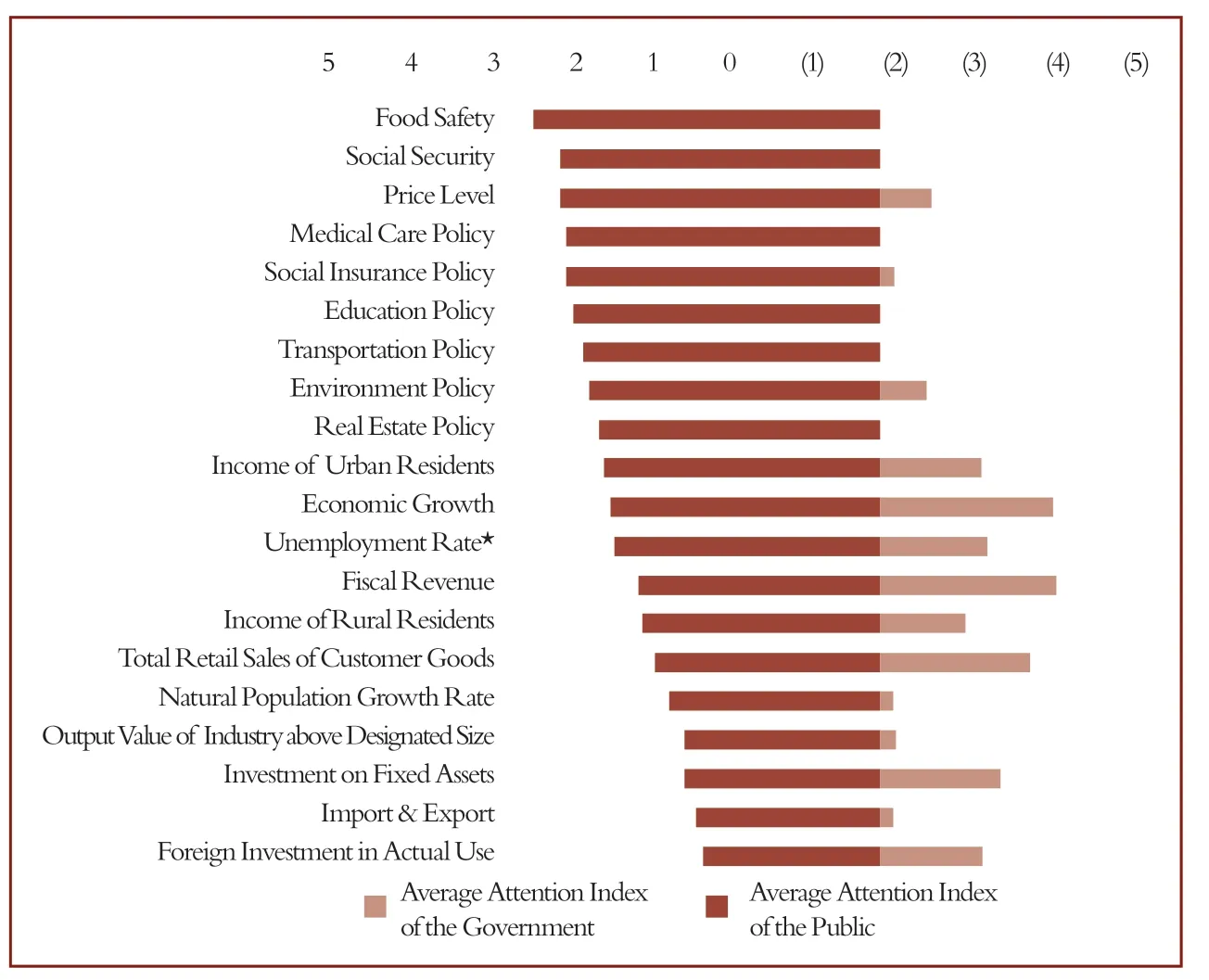
Fig. 2: Divergence between the government and the public in 19 cities for attention on policy issues in 2016
According to the questionnaire survey, the top five policy issues with the most attention from the public are food safety, public security, price levels, medical services and social security policies. It is evident that people’s attention to policies relates closely to their personal feelings about their quality of life. Indeed, similar results were found in other follow-up studies. The magazine Insight China and the media investigation laboratory of Tsinghua University carried out a follow-up investigation on “China’s comprehensive index of moderate prosperity” (2009-2015). It also indicated that the five policy issues with the highest public attention were “food safety,” “reform of medical care,” “anti-corruption,” “price levels” and “housing levels” (E, 2015). According to certain direct comparison between the public agenda and policy agenda during the NPC & CPPCC, “income distribution,” “anti-corruption,” “food and drug safety,” “social security” and “housing” remained dominant in the public agenda during the annual NPC and CPPCC sessions in 2013 - 2015. However, they were not included in the preferences of the public agenda in the GARS (Zeng, Wang & Wang, 2016).
As the text analysis of the government annual reports of 19 Chinese cities in 2016 shows, there is some convergence in the top five goals of the GARs of those cities, which were “economic growth,” “fiscal revenue,” “social consumption,” “investment on fixed assets,” and “registered urban unemployment rates” and these rankings have remained for many years (Yang & Wang, 2014). Obviously, the focus of local government policies reflected in their GARs diverge from the perspectives, logic and issues of public policy attention. So, our hypothesis Ha is confirmed. In the eyes of local government authorities, higher investment growth rates, sounder economic growth and higher fiscal revenues are the most glorious achievements in the annual work. However, for the general public,“food is the basic need,”①On August 29, 2016, the the General Office of the State Council issued the Notice of the Central Office of the State Council on Issuing the Measures for Food Safety Work, which means that the local governments will gradually put higher priorities on the food safety in the policy agenda.and what is most important for the public is that the macro and economic achievements can ultimately improve their lives, such as “improving employment” and “guaranteed school enrollment, better education, better labor guarantees, guaranteed lives for the old, guaranteed housing and poverty relief.” It is noticeable that the 19th National Congress of the Communist Party of China in 2017 put more priorities on the policy issues closely related to the qualities of people’s lives, which means the divergence between the public agenda and the policy agenda may be closing little by little.
4.2. High convergence in the ranking of public policy preferences
There was a high convergence in the rankings of public policy attention among different cities, industries, educational levels, ages, genders and interviewing sites (For details, see Table 1, Annex 1 and Annex 2), which is another interesting finding of this study. In respect of different types of industries, there was also high convergence in issues like “food safety” and “social security” with more public attention as well as issues like “foreign investment in actual use” and “import & export” with less public attention. Meanwhile, this convergence does not only exist in the policy preference ranking of the public agenda, but also in the GARs finally used by certain cities (Yang & Wang, 2014). Therefore, hypothesis Hb is inconsistent with the empirical data obtained in this study.

Table 1: The Convergence of Public Policy Preferences
Why do citizens randomly interviewed in different cities and under different circumstances have such highly convergent preferences of policy issues? Some economists believe that different people have quite different interests for various reasons, other than ignorance such as differences in natural gifts or acquired knowledge and skills (James & Gordon, 2000). Hence, how to explain this high convergence in the policy preference ranking of different groups?
This study showed that news media are rather frequently used by all the groups of people as the means for policy information acquisition (for details, see Fig. 5 and Fig. 6). According to some experts, mass media is likely to set the “agenda” for the public: the topics and events under greater spotlight of the media may attract more attention from the public; and the specific reports of the media as well as the ways they are expressed may endow the policy issues with various degrees of significance, influencing people’s judgment of the “great events” and their importance (Mccombs & Shaw, 1972). Furthermore, the media always fails to guide the readers thinking, but is remarkably successful in providing the readers with what to think (Scott, 1963). According to studies of Page and Shapiro, although individual opinions often blow hot and cold, public opinion was fairly convergent across the American society from the 1930s’ to the 1990s’. This reflects not only the stable value system shared by most Americans but also the high sensitivity of the public responding to new events, topics and information released by mass media (Page & Shapiro, 1992). As a result, the convergent public preference ranking is formed through media guidance.
4.3. Divergence between institutional staff and non-institutional staff
Referring to the user classification approach designed by Steccolini and Ryan, our study classified the interviewees as institutional staff and non-institutional staff, based on the industrial classification made by the National Bureau of Statistics. The people working in the authorities of the Communist Party of China and the state agencies (administrative, judicial and procuratorial organs) were included in the institutional staff, while those working in other industries are included in the non-institutional staff. This study measured both the institutional and the non-institutional staff's awareness of national and local GDP goals.

Fig.3: The institutional and non-institutional staff's attention to national and local GARs
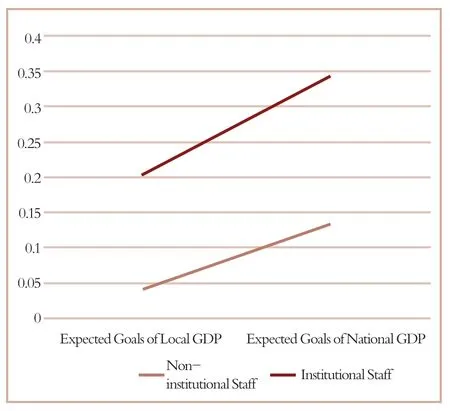
Fig.4: The institutional and non-institutional staff's awareness of national and local GDPs
As Fig. 3 and Fig. 4 show, institutional staff is significantly more aware of the expected targets of both local and national GDPs compared with the non-institutional staff. The values of variance T-test for the institutional and non-institutional staff's awareness of local and national GDP goals are 12.2410 and 14.0695 respectively, both with significance below 0.001. So, hypothesis Hc is verified.
4.4. Other factors related to policy communication of GARs.
According to Fig. 5 to Fig. 8, when it comes to the acquisition of governmental information, news media remains the first choice for people with different educational levels and at different ages. There is significant convergence in the communication modes of mass media with respect to educational levels and ages. It is noticeable that Microblog and Wechat have become windows for the public to acquire governmental information, due to the rapid growth of the Internet. This study shows that people with a higher education are more likely to employ the official government agenda, in respect of selecting direct channels to get information such as a “government annual report” and “statistical bulletin,” which is very interesting. Despite receiving policy propaganda and input passively, people with a higher education participate in the policy communication in a more active manner, since the wider selection of media and greater accessibility brought by higher education enable them to avoid the reprocessed media agenda.
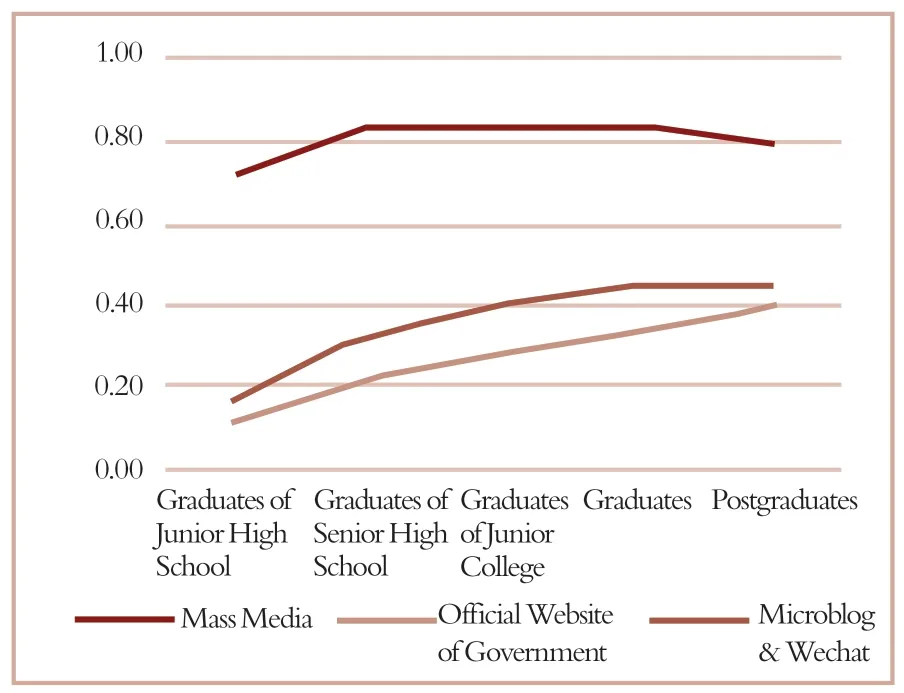
Fig.7: Birth year and channels used to obtain governmental information (I)
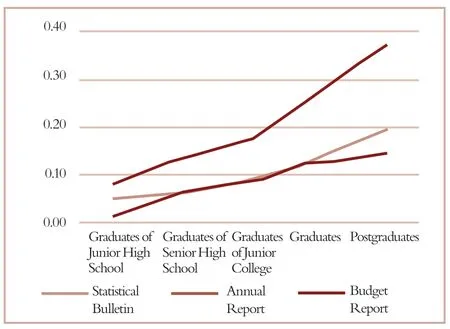
Fig.8: Birth year and channels used to obtain governmental information (II)
Hence, as higher education is popularized for more people, we can expect that direct channels of government communication, such as the GARs, will play increasingly important roles in the political lives of people.
5. Conclusion and discussion
Taking government annual reports, unique carriers of public policies in China, as the object, this study collected 6,470 valid questionnaires regarding public opinion in 19 cities by means of accidental sampling, discussed the policy communication process of GARs based on data analysis, and explored the interactive mechanisms between public agendas and policy agendas. According to the findings of this study, there is significant divergence between public attention and government attention in respect to policy preference rankings. Macro and economic indexes are attached greater importance to the government annual reports of 19 cities, while the public pays more attention to the livelihood indexes directly related to the qualities of their lives. In addition, this study also found that the institutional staff are more concerned about the GARs than the non-institutional staff, so it will take more effort and more time to make the GARs a direct channel of policy communication for the public. Hence, to improve the responsiveness of GARs will contribute to their better policy communication function.
The interesting findings of this study are the convergence of the policy preference rankings. Although public preferences significantly diverge from the governments’ agenda, there is generally high convergence in public policy preferences among different ages, occupations, genders, regions and educational levels, while the policy preferences in different cities’ GARs also show a high convergence. Therefore, during the interactions between the public and the policy makers, the convergence in the aforesaid two prospects will greatly facilitate the government to acquire public preference rankings and formulate proper policies. Meanwhile, it is important for the policy models based on the high divergence of public policy preference ranking to be reviewed and improved accordingly.
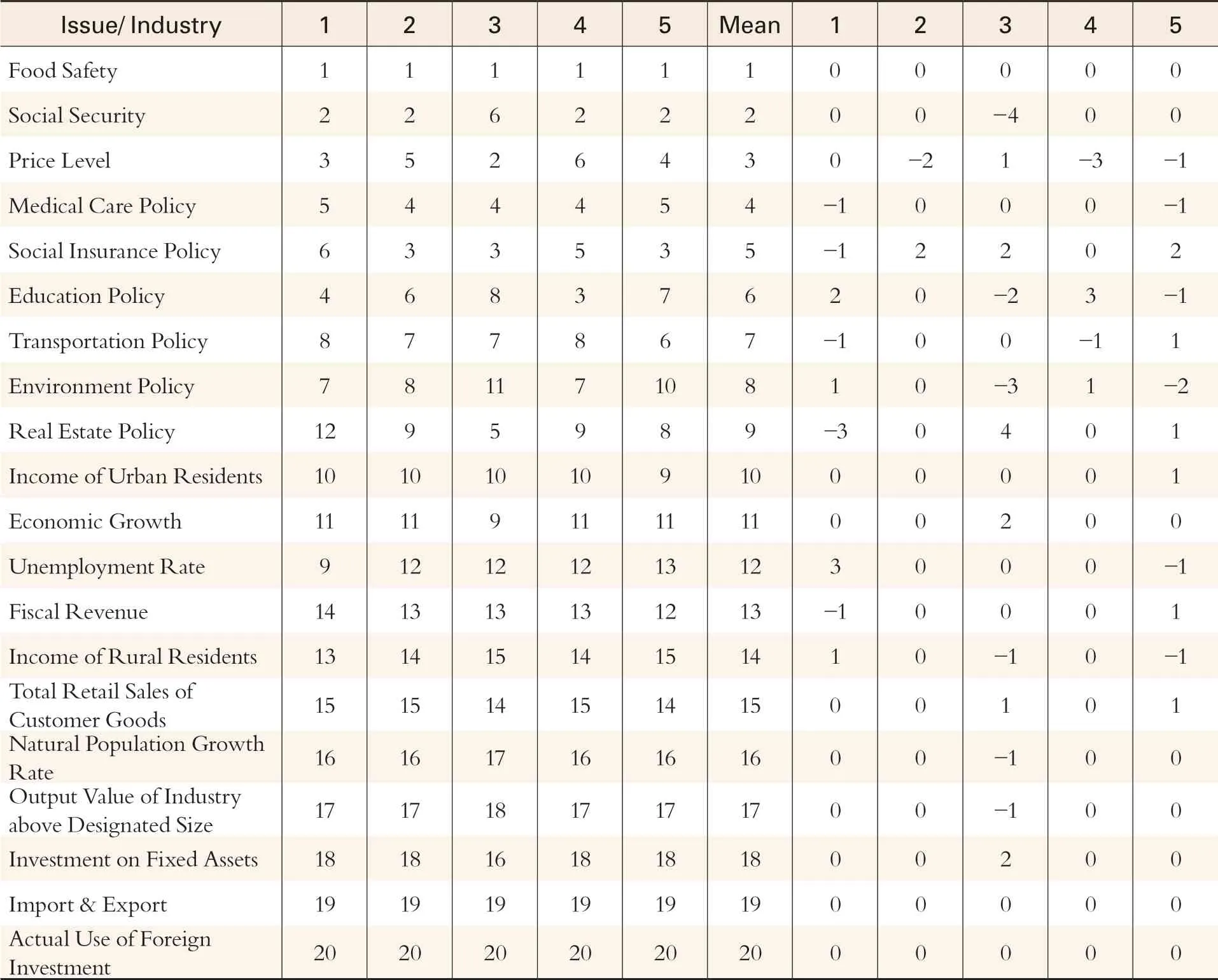
Annex 1: Attention to Policy Issues Across Different Industries(The Quinquepartite Method)

Annex 2: The Public Preference Ranking of 19 Cities
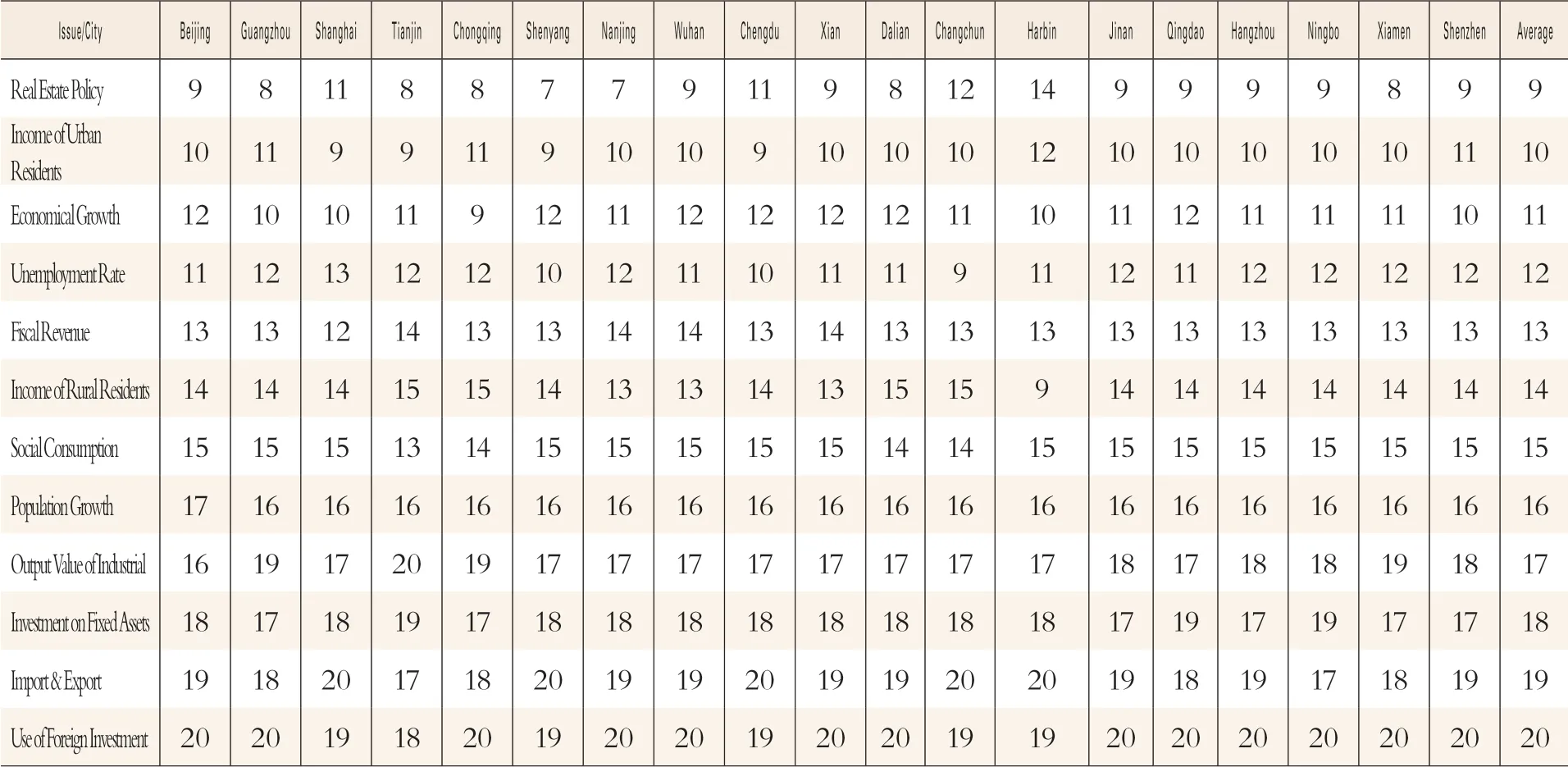
Issue/City Beijing Guangzhou Shanghai Tianjin Chongqing Shenyang Nanjing Wuhan Chengdu Xian Dalian Changchun Harbin Jinan Qingdao Hangzhou Ningbo Xiamen Shenzhen Average Real Estate Policy 9 8 11 8 8 7 7 9 11 9 8 12 14 9 9 9 9 8 9 9 Income of Urban Residents 10 11 9 9 11 9 10 10 9 10 10 10 12 10 10 10 10 10 11 10 Economical Growth 12 10 10 11 9 12 11 12 12 12 12 11 10 11 12 11 11 11 10 11 Unemployment Rate 11 12 13 12 12 10 12 11 10 11 11 9 11 12 11 12 12 12 12 12 Fiscal Revenue 13 13 12 14 13 13 14 14 13 14 13 13 13 13 13 13 13 13 13 13 Income of Rural Residents 14 14 14 15 15 14 13 13 14 13 15 15 9 14 14 14 14 14 14 14 Social Consumption 15 15 15 13 14 15 15 15 15 15 14 14 15 15 15 15 15 15 15 15 Population Growth 17 16 16 16 16 16 16 16 16 16 16 16 16 16 16 16 16 16 16 16 Output Value of Industrial 16 19 17 20 19 17 17 17 17 17 17 17 17 18 17 18 18 19 18 17 Investment on Fixed Assets 18 17 18 19 17 18 18 18 18 18 18 18 18 17 19 17 19 17 17 18 Import & Export 19 18 20 17 18 20 19 19 20 19 19 20 20 19 18 19 17 18 19 19 Use of Foreign Investment 20 20 19 18 20 19 20 20 19 20 20 19 19 20 20 20 20 20 20 20
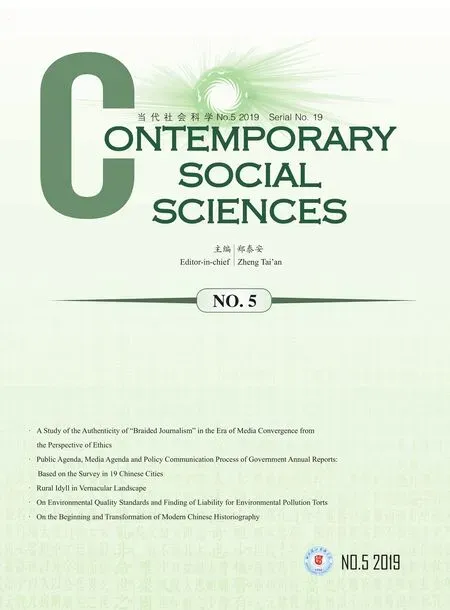 Contemporary Social Sciences2019年5期
Contemporary Social Sciences2019年5期
- Contemporary Social Sciences的其它文章
- American Sunday-School Libraries in the 19th century
- Discussion on the Appraisal of Ancient Chinese Calligraphies and Paintings
- Emotion and Memory: Emotional Guidance for the History Education of the Nanjing Massacre
- On the Beginning and Transformation of Modern Chinese Historiography
- Rural Idyll in Vernacular Landscape
- On Environmental Quality Standards and Finding of Liability for Environmental Pollution Torts
